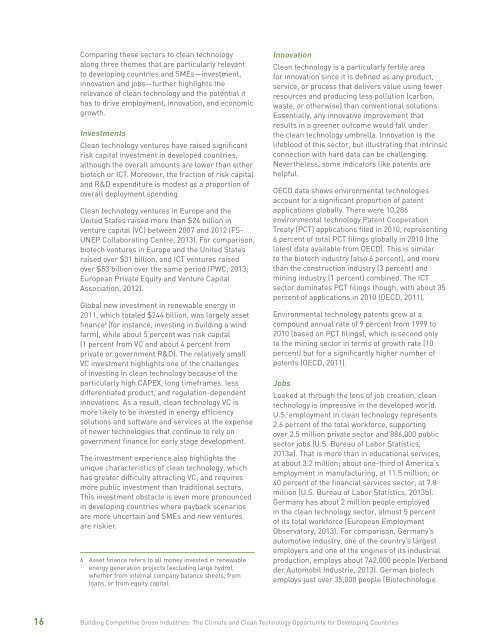Building Competitive Green Industries
green-industries
green-industries
Create successful ePaper yourself
Turn your PDF publications into a flip-book with our unique Google optimized e-Paper software.
Comparing these sectors to clean technologyalong three themes that are particularly relevantto developing countries and SMEs—investment,innovation and jobs—further highlights therelevance of clean technology and the potential ithas to drive employment, innovation, and economicgrowth.InvestmentsClean technology ventures have raised significantrisk capital investment in developed countries,although the overall amounts are lower than eitherbiotech or ICT. Moreover, the fraction of risk capitaland R&D expenditure is modest as a proportion ofoverall deployment spending.Clean technology ventures in Europe and theUnited States raised more than $24 billion inventure capital (VC) between 2007 and 2012 (FS-UNEP Collaborating Centre, 2013). For comparison,biotech ventures in Europe and the United Statesraised over $31 billion, and ICT ventures raisedover $53 billion over the same period (PWC, 2013;European Private Equity and Venture CapitalAssociation, 2012).Global new investment in renewable energy in2011, which totaled $244 billion, was largely assetfinance 6 (for instance, investing in building a windfarm), while about 5 percent was risk capital(1 percent from VC and about 4 percent fromprivate or government R&D). The relatively smallVC investment highlights one of the challengesof investing in clean technology because of theparticularly high CAPEX, long timeframes, lessdifferentiated product, and regulation-dependentinnovations. As a result, clean technology VC ismore likely to be invested in energy efficiencysolutions and software and services at the expenseof newer technologies that continue to rely ongovernment finance for early stage development.The investment experience also highlights theunique characteristics of clean technology, whichhas greater difficulty attracting VC, and requiresmore public investment than traditional sectors.This investment obstacle is even more pronouncedin developing countries where payback scenariosare more uncertain and SMEs and new venturesare riskier.6 Asset finance refers to all money invested in renewableenergy generation projects (excluding large hydro),whether from internal company balance sheets, fromloans, or from equity capital.InnovationClean technology is a particularly fertile areafor innovation since it is defined as any product,service, or process that delivers value using fewerresources and producing less pollution (carbon,waste, or otherwise) than conventional solutions.Essentially, any innovative improvement thatresults in a greener outcome would fall underthe clean technology umbrella. Innovation is thelifeblood of this sector, but illustrating that intrinsicconnection with hard data can be challenging.Nevertheless, some indicators like patents arehelpful.OECD data shows environmental technologiesaccount for a significant proportion of patentapplications globally. There were 10,286environmental technology Patent CooperationTreaty (PCT) applications filed in 2010, representing6 percent of total PCT filings globally in 2010 (thelatest data available from OECD). This is similarto the biotech industry (also 6 percent), and morethan the construction industry (3 percent) andmining industry (1 percent) combined. The ICTsector dominates PCT filings though, with about 35percent of applications in 2010 (OECD, 2011).Environmental technology patents grew at acompound annual rate of 9 percent from 1999 to2010 (based on PCT filings), which is second onlyto the mining sector in terms of growth rate (10percent) but for a significantly higher number ofpatents (OECD, 2011).JobsLooked at through the lens of job creation, cleantechnology is impressive in the developed world.U.S. employment in clean technology represents2.6 percent of the total workforce, supportingover 2.5 million private sector and 886,000 publicsector jobs (U.S. Bureau of Labor Statistics,2013a). That is more than in educational services,at about 3.2 million; about one-third of America’semployment in manufacturing, at 11.5 million; or40 percent of the financial services sector, at 7.8million (U.S. Bureau of Labor Statistics, 2013b).Germany has about 2 million people employedin the clean technology sector, almost 5 percentof its total workforce (European EmploymentObservatory, 2013). For comparison, Germany’sautomotive industry, one of the country’s largestemployers and one of the engines of its industrialproduction, employs about 742,000 people (Verbandder Automobil Industrie, 2013). German biotechemploys just over 35,000 people (Biotechnologie.16 <strong>Building</strong> <strong>Competitive</strong> <strong>Green</strong> <strong>Industries</strong>: The Climate and Clean Technology Opportunity for Developing Countries


